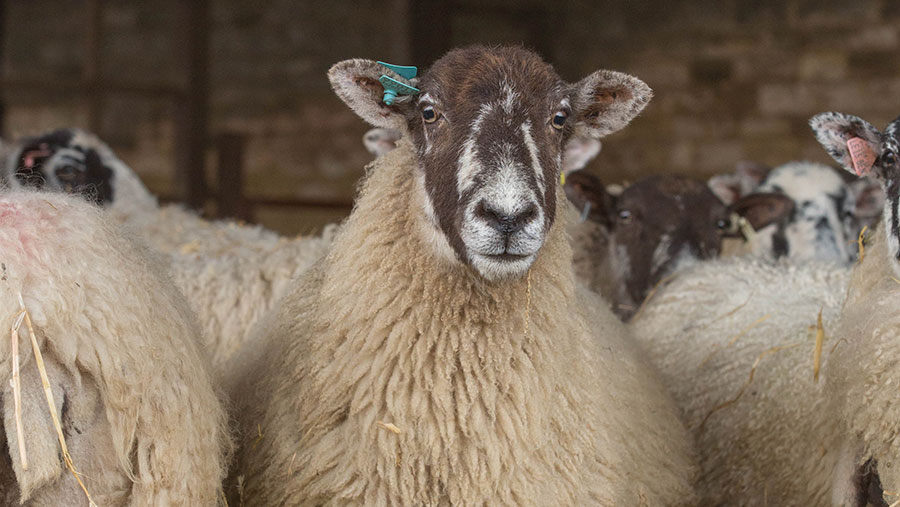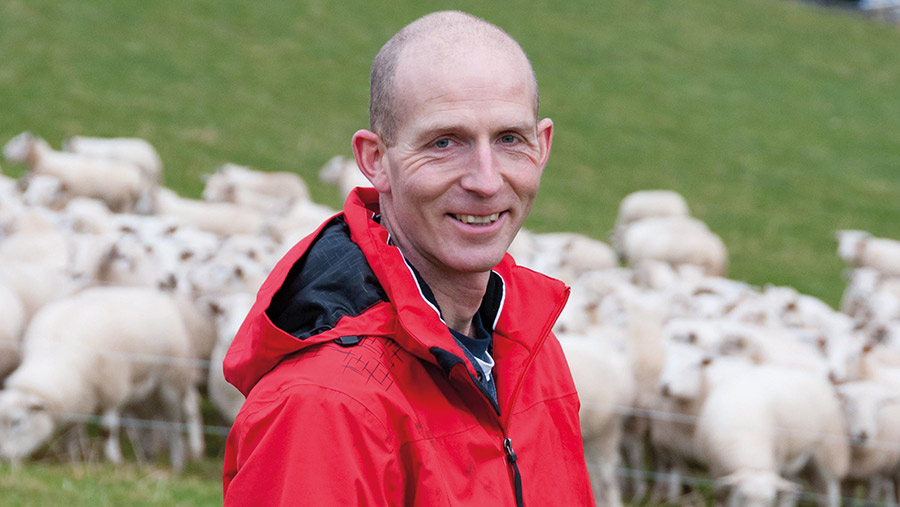Why lamb losses are half the industry average on Scots farm
 © Tim Scrivener
© Tim Scrivener Lambing losses at Bankhouse Farm, Galashiels, have averaged 7% over the past five years. This is half the average for Scottish upland flocks, according to QMS data (see “Bankhouse Farm lamb mortality figures”).
Farmer Graham Lofthouse, whose flock of Easycare ewes produces about 1,000 lambs a year, says nutrition and flock management are key to reducing losses.
Below, he sets out what he is doing.
See also: Expert advice on assessing and managing lambing difficulties
Farm facts: Bankhouse Farm, Galashiels, Scotland
- 452 Easycare ewes
- 147 Easycare ewe lambs
- 16 tups/tup lambs
- Average of 1,000 lambs sold/retained
- Lambing starts 6 April
Nutrition
To achieve minimal losses at lambing time, the biggest focus is on nutrition.
Because of the nature of the farm, Mr Lofthouse lambs some ewes inside and some outdoors. Before lambing, all the ewes weigh in at about 70kg.
The secret to doing well on an indoor system is keeping the feeding simple, he says.
The base diet consists mainly of silage, plus 0.3kg of wheat dark grains, bringing the total ration to metabolisable energy (ME) of 11.6MJ/kg dry matter (DM) and 16% crude protein/kg DM.
About four weeks from lambing, triplet ewes get an extra 0.2kg of wheat dark grains, top-dressed on the base ration.
Singles are fed the base diet every other day, with plain silage in between.
Bankhouse Farm lamb mortality figures |
|||
|
Year |
Scan |
Mortality lambing |
Mortality to sale |
|
2021 |
189% |
7.5% |
8.5% |
|
2020 |
188% |
6.8% |
7.4% |
|
2019 |
194% |
7% |
7.9% |
|
2018 |
194% |
5% |
6% |
|
2017 |
181% |
9% |
10.3% |
|
Source: Graham Lofthouse. Industry average mortality, according to QMS 2021 upland ewe flocks technical performance, is 14% |
|||
Flock management
The management of ewes both before and after lambing is also fundamental to minimising losses.
Pre-lambing:
- Grouping ewes Ewes are brought in six weeks pre-lambing and split into scan groups. Body condition score is assessed, with a target of 3. If a ewe carrying a single lamb is underweight she is moved to the feeding level for twins. Similarly, a twin-bearing ewe needing extra feed is moved in with the ewes carrying triplets. Anything in the triplet group which is not coping on the feeding regime goes out to the best available grass until lambing time.
- Feed space Every ewe has a feed space available.
- Blood test A beta-hydroxybutyrate (BOHB) test is carried out by the University of Edinburgh on about 20 twin/triplet ewes one month before lambing. This is a good indicator of whether there is enough protein and energy in the diet in the run up to lambing, with elevated ketosis levels a sign of an imbalance. It can give an indication of long-term protein levels, too.
- Bedding and hygiene The farm has a straw-based system, bedding every third day with spring barley straw in the main grouping sheds. If sheds are occupied for longer than six weeks before lambing, they are mucked out completely three to four weeks prior to lambing.
- Individual pens Within the group pens, individual pens are used as animals lamb. The pen is moved to the ewe – rather than the other way around – to minimise stress. Once she has lambed and bonded with her lambs, she is moved to an individual pen in the post-lambing area.
Post-lambing:
- Stress management It is essential to keep stress levels low to maintain condition and ewe health.
- Iodine The lambs are cleaned with iodine twice. The first application is given just before they come into the post-lambing area. At this point ewes are also checked for milk supply and colostrum availability. A second application of iodine is done 4-6 hours later.
- Water This is crucial for milk supply. A pipe is fitted through the passageway to ensure fresh water is always available. A flush system keeps it clean.
- Nutrition The same pre-lambing base ration is fed post-lambing. Changing it too much can be detrimental to the ewe’s health and milk supply. However, rations are supplemented with 0.3kg of blend after lambing. This consists of wheat dark grains and a small amount of rolled barley to help with energy levels and protein.
- Group pens Twins and triplets will be put into group pens after 24 hours, and turned out a further 24 hours later. Single ewes are turned out within 12-24 hours of birth.

Graham Lofthouse © QMS
Strategic turnout
Grass availability is key to turnout, says Mr Lofthouse. He works off targeted grazing heights to allow ewes to milk sufficiently without needing further supplementation.
His targets are:
- Singles: minimum of 4cm
- Twins/triplets: 5-6cm
Support feeds are sometimes necessary in difficult years. For example, if grass levels are below 4cm for twins, 0.5kg of supplementary feed is given at either end of the day.
Graham Lofthouse on why losses occur
-
Body condition score
Sub-optimal body condition score has an impact on ovulation, the placenta, colostrum, milk supply and milking ability – all of which can affect lamb performance/losses. Whether you run an indoor or outdoor system, these basic principles will be the same.
-
Nutrition
An imbalance in nutrition can affect embryo implantation, lamb birth weight and colostrum supply, as well as the lifetime performance of the ewe. Even more importantly, it will affect the lambs she produces.
-
Genetics
Genetics also have a big influence on lamb losses. Pelvic size can affect mortality rates, while ovulation rate will dictate how many lambs are born. The maternal ability of the ewe – how good a mother she is – obviously plays a role, too.
-
The farmer
The main factor which links all these together is the farmer, who probably has the biggest influence on everything that happens on farm – both positive and negative.
Mr Lofthouse was speaking at a recent webinar on minimising losses at lambing hosted by SAC Consulting – part of Scotland’s Rural College.
